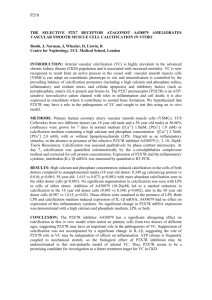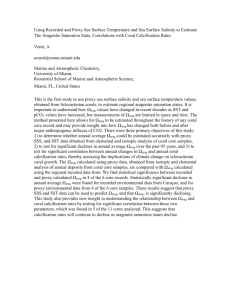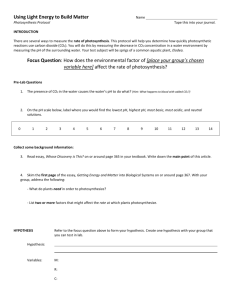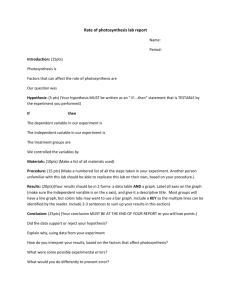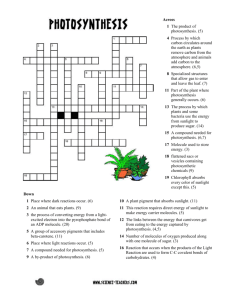reef experiments
advertisement
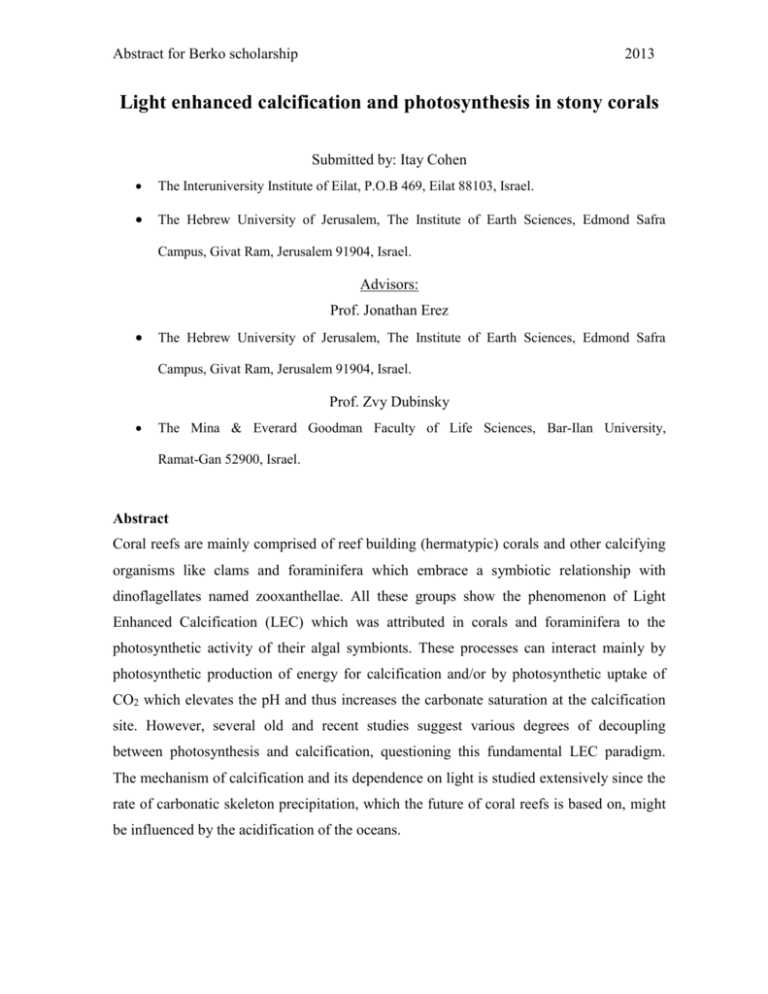
Abstract for Berko scholarship 2013 Light enhanced calcification and photosynthesis in stony corals Submitted by: Itay Cohen The Interuniversity Institute of Eilat, P.O.B 469, Eilat 88103, Israel. The Hebrew University of Jerusalem, The Institute of Earth Sciences, Edmond Safra Campus, Givat Ram, Jerusalem 91904, Israel. Advisors: Prof. Jonathan Erez The Hebrew University of Jerusalem, The Institute of Earth Sciences, Edmond Safra Campus, Givat Ram, Jerusalem 91904, Israel. Prof. Zvy Dubinsky The Mina & Everard Goodman Faculty of Life Sciences, Bar-Ilan University, Ramat-Gan 52900, Israel. Abstract Coral reefs are mainly comprised of reef building (hermatypic) corals and other calcifying organisms like clams and foraminifera which embrace a symbiotic relationship with dinoflagellates named zooxanthellae. All these groups show the phenomenon of Light Enhanced Calcification (LEC) which was attributed in corals and foraminifera to the photosynthetic activity of their algal symbionts. These processes can interact mainly by photosynthetic production of energy for calcification and/or by photosynthetic uptake of CO2 which elevates the pH and thus increases the carbonate saturation at the calcification site. However, several old and recent studies suggest various degrees of decoupling between photosynthesis and calcification, questioning this fundamental LEC paradigm. The mechanism of calcification and its dependence on light is studied extensively since the rate of carbonatic skeleton precipitation, which the future of coral reefs is based on, might be influenced by the acidification of the oceans. The experiments in my PhD are designed to investigate the nature of relationship between calcification and photosynthesis in reef building corals and will try to determine the conditions by which these processes are mutual, competitors or indifferent to one another. We examined the effects of inhibition of either photosynthesis or Ca2+ transport on LEC in the corals Pocillopora damicornis and Acropora variabilis. Former studies showed that in the presence of the photosynthetic inhibitor DCMU, rates of calcification declined simultaneously to photosynthesis as a response to a short term use (several minutes to an hour). In this study we incubated coral fragments with much lower concentrations and for longer time. Photosynthetic O2 production decreased with time exposure (up to 48-54 hours) and with increased concentration, to levels below compensation point (O2 consumption was greater than its production) in both species. At the same time LEC showed normal values throughout the whole experiment in P. damicornis, and for 24 hours in A. variabilis. These results exclude the possibility that calcification was enhanced by photosynthetic CO2 uptake during light in both of these species. Incubating coral fragments for 96 hours with the chemicals Verapamil (Ca2+ channel blocker) or Ruthenium red (Ca2+-ATPase blocker) inhibited both light and dark calcification in P. damicornis, implying that Ca2+ transport is normally active during the day and night. Calcification in A. variabilis however was inhibited mostly during the day and only slightly at night. Since calcification in A. variabilis was also inhibited after 24 hours in DCMU and Ca2+-ATPase is mostly active during the day in this coral, we suggest that Ca2+ATPase activity may be coupled with photosynthetic energy production in A. variabilis to a larger extent than in P. damicornis. This study introduces a more complex interaction between calcification and photosynthesis than what was estimated before, suggesting a possibility of specie specific mechanism of LEC. At a different experiment we tested the possibility that light enhanced calcification can be driven by light dependent processes, other than photosynthesis. Action spectrum of calcification and photosynthesis was measured at a series of incubations by exposing the corals to increasing light intensities in several parts of the spectrum. Assessing the magnitude by which calcification and photosynthesis spectrally overlap provides the opportunity to reevaluate the basic characteristics of LEC and determine in a non-intrusive method the magnitude by which calcification is activated by light or by photosynthesis. Our results show that calcification is usually saturated at lower irradiance levels relative to photosynthesis and the action spectra of these processes are highly different among some corals. Illumination of blue light evidently supports high calcification rates in Acropora variabilis and Porites lutea, whereas photosynthetic oxygen production was dramatically inhibited, such that it remained below compensation point even under light intensity of 400 µmol photons m-2 s-1. This supports the working hypothesis of the first experiment that calcification in some cases can be enhanced by light regardless of the photosynthesis of the symbiotic alga. Photoreceptors of the blue region of the spectrum, named cryptochromes were recently found in corals. These receptors are known to synchronize the circadian rhythm but their role in the mechanism of calcification is yet to be tested. In plants these receptors are responsible for phototropism and directional growth toward light by activation of proton pumps, which may also have a dominant role in coral calcification. It is necessary to examine whether corals share similar cascade, which could possibly explain some of the processes responsible for LEC. Low light intensity is usually sufficient for activation of photoreceptors, unlike efficient photosynthesis; this could explain why calcification is usually saturated much before photosynthesis. The results of this study are surprising and orthogonal to the common thinking on LEC in hermatypic corals. If indeed LEC is decoupled from photosynthesis in corals, this would be a major change in our understanding of their symbiotic relationship which may have important implication for their evolution and role in the oceanic carbon cycle. Although oxygen was produced at very low levels as a response to the blue light, zooxanthellae could still produce ATP by cyclic photophosphorylation in photosystem I, one of the light-dependent reactions of photosynthesis. Therefore a current study is comparing the effects of blue light on calcification rates of corals that have lost their zooxanthellae. In addition, in a future experiment we will use a novel and very sensitive method to measure photosynthesis called photocoustics in healthy corals. This experiment is designed to evaluate the importance of energy contribution derived from PSI to the enhancing calcification effect. I can summaries all we currently know about this phenomena in one sentence: In light of light, light corals become heavier (but not only)…
